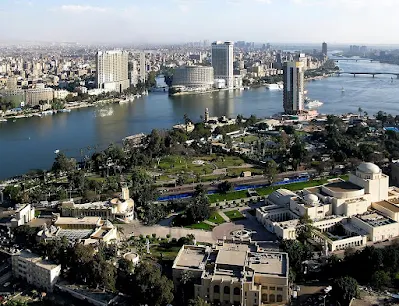20 Interesting Facts About the Nile River
- The Nile, a river in northeastern Africa, is the world’s longest river. It flows from south to north and drains into the Mediterranean Sea.
- The Nile, with a total length of 6,695 km (4,160 miles), is the longest river in the world. Its primary source is Lake Victoria, while the farthest point is a stream in Burundi. On the other hand, the disputed maximum length of the Amazon River is 6,750 km (4,195 miles). However, its ending point is uncertain, which makes it the second-longest river. (Source)
- Despite being the longest river, the Nile has less discharge than many other rivers. The largest river by discharge is the Amazon River (nearly 209,000 cubic meters per second). Comparatively, the discharge of the Nile River is only 2,830 cubic meters per second.
- The Nile River basin covers nearly 10% of Africa in several countries. These include Egypt, Sudan, South Sudan, Eritrea, Ethiopia, Kenya, DR Congo, Burundi, Rwanda, Uganda, and Tanzania.
- The Nile has two primary tributaries: the Blue Nile and the White Nile rivers. The origins of these rivers are Lake Tana (Ethiopia) and Lake Victoria. Both these rivers join at Khartoum, the capital of Sudan.
- According to estimates, humans started living along the banks of the Nile River around 6000 BC. The river assisted in developing two ancient civilizations: Egyptian and Nubian. These human settlements took advantage of numerous fish in the water, various plants that grew along its banks, and a rich layer of silt for agriculture after annual floods in the Nile.
- More than 50% of the Egyptian population resides in the Nile Delta. It supports 63% of the country’s agriculture and over 12% of the fish production. It is also a major route and stopover site for millions of birds migrating between Africa and Europe annually. (Source)

Majority Egyptian population lives around the Nile - The White Nile loses nearly half of its discharge while passing through the Sudd swamps in South Sudan. It happens due to evapotranspiration and seepage. (Source)
- The Ancient Egyptian calendar was the first known calendar with 365 days a year. The Egyptians divided this calendar according to the flood, spring, and harvest seasons of the Nile.
- A British explorer, John Hanning Speke, was the first person to discover Lake Victoria as the source of the Nile River. He found this lake alone in 1858 and re-confirmed this discovery with several companions in 1862. (Source)
- The Nile Delta is one of the world’s three locations most vulnerable to global warming. Climate change has reduced the flow of the Nile in 50 years from 3,000 cubic meters per second to 2,830. If the recent trend continues, the river flow can fall by 70% by 2100. (Source)
- Egypt constructed the Aswan High Dam in 1970 across the Nile River. This dam established human control over the annual Nile flood for the first time. It also generated over 2,000MW of hydroelectric power and supported the fishing industry.
- The Aswan Dam also has several drawbacks. It forced the relocation of hundreds of thousands of people (Egyptians and Sudanese) and damaged several archaeological sites. The dam also reduced the fertility of the land by carrying rich silt of the river to canals and reservoirs.
- The Nile takes a deep U-shaped bend in the area located in the middle of the Nile Delta and the Sudanese border. It is known as the “Great Bend,” while the previous name of this location was the Valley of the Kings. (Source)
- Ethiopia started the construction of GERD (the Grand Ethiopian Renaissance Dam) on the Blue Nile in 2011, while the filling of its reservoirs began in 2020. It is the largest hydropower plant in Africa, while Aswan and GERD are among the world’s largest dams. Egypt and Sudan have several reservations over this dam because it can reduce the discharge to these downstream countries. The GERD filled for the first time in September 2023.
- The Nile River supports a diverse animal life. These include several freshwater fishes (Nile perch, catfish, tigerfish, lungfish, etc.), reptiles (Nile crocodiles, monitor lizards, snakes, and soft-shelled turtles), and mammals (hippos).
- Papyrus is one of many plants that grow along the Nile River. Ancient Egyptians used this plant to make paper, cloths, mats, and cords.
- According to previous estimates, the Nile has maintained its current path for 6 million years. However, recent geological and geodynamic studies suggest the Nile drainage is 30 million years old. (Source)
- There was a belief in Ancient Egypt that the dead dwell in the west. Therefore, most of the tombs of this period are on the western side of the Nile.
- Egyptians celebrate the Wafaa El Nil (Fidelity of the Nile) festival for two weeks from August 15 annually. The event started in Ancient Egypt, where people thanked the Nile for its annual floods.



Comments
Post a Comment